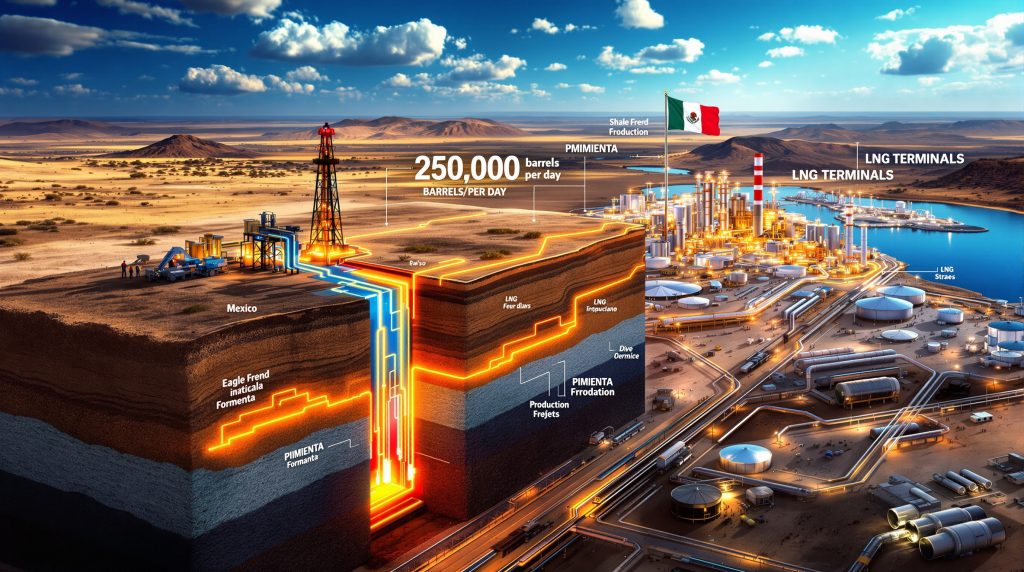What Are Mexico's Unconventional Oil Resources?
Mexico possesses significant unconventional hydrocarbon resources, primarily concentrated in the Pimienta and Eagle Ford formations. These geological structures extend from the prolific U.S. Eagle Ford play across the border into northern Mexico, containing substantial reserves of both oil and natural gas that remain largely undeveloped. Unlike conventional reservoirs, these formations require specialized extraction techniques such as hydraulic fracturing and horizontal drilling to access the hydrocarbons trapped in tight rock formations.
The geology of these formations consists primarily of limestone and shale rock with low permeability, making them technically challenging but potentially highly rewarding targets for development. The tight rock formations require fracturing to create pathways for oil and gas to flow into production wells.
Key Mexican Unconventional Formations
-
Pimienta Formation: A limestone-rich formation with significant oil and gas potential, characterized by high organic content and favorable pressure conditions
-
Mexican Eagle Ford: The southern extension of the productive U.S. Eagle Ford shale, sharing similar geological properties but with varying thickness and thermal maturity
-
Tampico-Misantla Basin: Contains multiple unconventional resource opportunities including tight oil formations with varying degrees of thermal maturity
-
Burgos Basin: Primarily gas-focused but with associated liquids potential, located strategically near existing pipeline infrastructure
These formations represent a potential game-changer for Mexico's energy landscape, with preliminary assessments indicating world-class resource quality in certain areas that could rival the productivity seen in U.S. basins.
How Does Mexico's Strategic Plan Address Unconventional Oil?
The recently unveiled Pemex Strategic Plan 2025–2035 represents a comprehensive roadmap for revitalizing Mexico's hydrocarbon sector. This plan explicitly targets Mexican unconventional oil plays as a key component in reversing the country's production decline and achieving energy sovereignty.
"The strategy needs major capital investment and international operators working under profitable contract terms. However, it's encouraging that the government and Pemex leadership are tackling natural gas production challenges by promoting development of the nation's extensive unexploited unconventional reserves," noted Ismael Hernandez, Research Associate at Wood Mackenzie in his analysis of the plan.
The plan marks a significant shift in Mexico's approach to its hydrocarbon resources, acknowledging the limitations of conventional production and embracing the potential of unconventional plays to transform the national energy landscape.
Core Elements of the 2025-2035 Strategic Plan
-
Production Target: Increase oil output to 1.8 million barrels per day by 2030, with unconventional resources playing a crucial role in meeting this objective
-
Natural Gas Focus: Significantly boost domestic gas production to reduce import dependence, currently standing at approximately 70% of national consumption
-
Funding Strategy: Combine government support with private partnerships to overcome capital constraints and technical challenges
-
Energy Transition Integration: Incorporate hydrogen and geothermal projects alongside hydrocarbon development to create a more balanced energy portfolio
According to industry analysts, early development of the Pimienta and Eagle Ford formations could yield approximately 250,000 barrels per day of liquids and 500 million cubic feet per day of natural gas by the early 2030s, providing a substantial boost to Mexico's energy portfolio.
Why Has Mexico Delayed Unconventional Development Until Now?
Mexico's unconventional resources have remained largely untapped despite their significant potential, due to several interconnected challenges that have hindered development efforts.
The contrast with neighboring Texas is stark – while the Eagle Ford play in the United States has transformed the energy landscape with thousands of productive wells, the Mexican side of the formation remains virtually untouched despite sharing similar geological characteristics.
Historical Barriers to Unconventional Development
-
Regulatory Uncertainty: Fluctuating policy positions on hydraulic fracturing have created an unpredictable investment environment, with previous administrations sending mixed signals about whether the technique would be permitted
-
Technical Expertise Gap: Limited domestic experience with unconventional extraction techniques has hampered Pemex's ability to efficiently develop these resources without external support
-
Infrastructure Limitations: Insufficient pipeline networks and processing facilities in key regions would require significant capital investment before commercial development could proceed
-
Capital Constraints: Pemex's financial difficulties restricting investment capacity, forcing the company to prioritize conventional assets with lower upfront costs
-
Environmental Concerns: Public opposition to fracking in certain regions has created social license challenges that would need to be addressed through comprehensive engagement strategies
The current administration's strategic pivot toward these resources signals a recognition that conventional production alone cannot meet Mexico's energy objectives, necessitating a more diverse approach to resource development.
What Production Potential Do Mexico's Unconventional Plays Hold?
The production potential from Mexico's unconventional resources is substantial, with industry assessments suggesting these plays could significantly alter the country's oil price dynamics over the next decade.
Geological analysis indicates that Mexico's formations share many of the characteristics that have made U.S. shale plays successful, including favorable rock properties, organic content, and thermal maturity in key zones.
Production Projections and Resource Estimates
-
Liquids Production: Potential to reach 250,000 barrels per day by early 2030s from unconventional formations
-
Natural Gas Output: Estimated 500 million cubic feet daily from unconventional sources, equivalent to approximately 20% of Mexico's current import volume
-
Resource Distribution: Primarily concentrated in northern Mexico near the U.S. border, with additional potential in the Tampico-Misantla Basin
-
Development Timeline: Initial production could begin within 3-5 years of investment approval, with full-scale development requiring 7-10 years
Wood Mackenzie's analysis indicates that Mexico's unconventional formations share favorable geological characteristics with their U.S. counterparts, suggesting comparable productivity could be achieved with appropriate technology application and investment.
The production potential varies significantly across Mexico's basins, with sweet spots likely to emerge as early exploration activities identify the most promising geological windows for development.
How Does Pemex's Financial Situation Impact Development Plans?
Pemex's challenging financial position represents perhaps the most significant obstacle to realizing Mexico's unconventional production potential. As the world's most indebted oil company, Pemex faces substantial constraints on its ability to fund new development initiatives.
The company's debt burden has grown dramatically over the past decade, limiting its capacity to invest in new technologies and exploration activities, particularly in capital-intensive unconventional plays that require continuous drilling programs.
Pemex's Financial Challenges
-
Total Debt: Nearly $100 billion, the highest of any oil company globally, placing severe constraints on new project development
-
Total Liabilities: Approximately $233.4 billion as of 2023, up from $121.9 billion in 2010, representing a nearly 100% increase
-
Profitability Issues: Posted profits in only three of the past 15 years, reflecting structural challenges in both upstream and downstream operations
-
Refining Losses: Persistent negative margins in downstream operations, with refineries operating well below capacity and requiring significant modernization
-
Recent Performance: Net loss of approximately $30 billion (190.5 billion pesos) in 2024, though with signs of improvement in early 2025
The government's strategic plan acknowledges these financial realities, proposing a combination of debt reduction measures, tax incentives, and private partnerships to create a more sustainable financial foundation for unconventional resource development.
Recent developments offer some cause for optimism, with the government committing to a $12 billion injection to help reduce Pemex's debt burden, and expectations that the company could become financially self-sufficient as early as 2027.
What Role Will Private Investment Play in Mexico's Unconventional Sector?
The success of Mexico's unconventional development ambitions will likely depend significantly on private sector participation, representing a potential shift in the country's approach to energy investment.
The technical complexity and capital requirements of unconventional development make it difficult for Pemex to undertake alone, creating an opportunity for collaborative approaches that leverage the expertise and financial resources of international operators.
Private Investment Framework
-
Partnership Models: Joint ventures, farm-ins, and service contracts designed to balance national control with private sector participation
-
Capital Requirements: Estimated $15-20 billion needed for initial development phase over a 5-7 year period to establish commercial production
-
Technical Collaboration: Access to expertise from experienced shale operators, particularly those with relevant experience in analogous formations
-
Risk Sharing: Distribution of exploration and development risks between Pemex and private partners to optimize capital efficiency
-
Government Incentives: Potential tax benefits and streamlined approval processes to attract investment in priority regions
Industry experts emphasize that attracting private investment will require establishing competitive fiscal terms and contract stability to offset the technical and economic risks associated with unconventional development.
The success of any private investment framework will depend on finding the right balance between national interest and commercial viability, ensuring that both Pemex and potential partners can achieve their strategic objectives.
How Would Unconventional Development Impact Mexico's Energy Security?
Successful development of Mexico's unconventional resources could substantially enhance the country's energy security position, reducing dependence on imports and creating greater supply resilience.
Mexico currently imports approximately 70% of its natural gas consumption and significant volumes of refined products, creating vulnerability to supply disruptions and price volatility in international markets.
Energy Security Implications
-
Natural Gas Self-Sufficiency: Potential to significantly reduce U.S. gas import dependence, which currently costs Mexico billions of dollars annually
-
Domestic Supply Chain: Development of local service and equipment providers, creating a more resilient industrial ecosystem for the energy sector
-
Price Stability: Reduced exposure to international market volatility through greater control over domestic production
-
Regional Energy Hub: Potential for Mexico to become a key energy supplier in Latin America if production exceeds domestic needs
-
LNG Export Opportunities: Possible development of Pacific Coast export terminals supplied partially by domestic production rather than re-exported U.S. gas
The strategic plan explicitly frames unconventional development as a sovereignty issue, highlighting the national security benefits of reducing energy import dependence.
Beyond the direct supply security benefits, developing a domestic unconventional sector would create thousands of high-skilled jobs and technical capabilities that could benefit the broader Mexican economy.
What Environmental Considerations Apply to Mexican Unconventional Development?
Environmental considerations represent a critical dimension of Mexico's unconventional development plans, with water usage and emissions impacts requiring particular attention.
The arid conditions in northern Mexico, where many of the most promising unconventional resources are located, create specific challenges for water management that differ from those faced in U.S. shale plays.
Environmental Management Framework
-
Water Management: Strategies for responsible sourcing and treatment of fracturing fluids, including potential for recycling and reuse technologies
-
Emissions Control: Methane leak detection and repair programs to minimize greenhouse gas impacts, particularly important given methane's high global warming potential
-
Land Use Planning: Minimizing surface footprint through multi-well pad development and thoughtful infrastructure design
-
Regulatory Oversight: Environmental impact assessment requirements specific to unconventional operations
-
Community Engagement: Transparent communication with affected populations about potential impacts and mitigation measures
The strategic plan acknowledges these environmental dimensions, proposing to implement best practices from other jurisdictions while adapting them to Mexico's specific ecological contexts.
Successful environmental management will require balancing development objectives with protection of water resources, air quality, and biodiversity, particularly in ecologically sensitive regions.
What Technical Challenges Must Mexico Overcome?
Developing Mexico's unconventional resources will require addressing several technical challenges unique to these geological formations and Mexico's operating environment.
While the fundamental techniques of horizontal drilling and hydraulic fracturing are well-established, their application to Mexico's specific geological conditions will require customization and optimization.
Key Technical Considerations
-
Formation Evaluation: Detailed characterization of reservoir properties including mineralogy, organic content, and natural fracture networks
-
Completion Optimization: Tailoring fracturing designs to Mexican geology, which may differ from U.S. analogs in critical parameters
-
Water Logistics: Securing sufficient water resources in arid northern regions, potentially requiring investment in water treatment infrastructure
-
Infrastructure Development: Building gathering systems and processing facilities in regions with limited existing oil and gas infrastructure
-
Workforce Development: Training specialized technical personnel capable of implementing advanced drilling and completion techniques
Industry analysts note that while these challenges are significant, they are not insurmountable given the extensive knowledge base developed in U.S. oil production challenges over the past two decades.
The learning curve could be accelerated through international partnerships that transfer knowledge and technology, allowing Mexico to benefit from lessons learned in more mature unconventional basins.
How Does Mexico's LNG Strategy Connect to Unconventional Development?
Mexico's ambitions in liquefied natural gas (LNG) export are closely linked to its unconventional development plans, creating potential synergies between domestic production and international market access.
The country's geographical position provides a unique advantage for LNG exports to Asia, with Pacific Coast terminals offering shorter shipping routes compared to U.S. Gulf Coast facilities.
LNG Development Strategy
-
Pacific Coast Terminals: Five major export facilities planned to capitalize on favorable geography and growing Asian demand
-
Feed Gas Sources: Combination of U.S. imports and domestic production, with unconventional gas potentially providing a significant portion of supply
-
Asian Market Focus: Targeting premium buyers in Japan, Korea, and China willing to pay $10-14 per MMBtu, compared to much lower domestic U.S. prices
-
Cost Advantages: Shorter shipping routes to Asia compared to U.S. Gulf Coast, reducing transportation costs and improving competitiveness
-
Infrastructure Requirements: Pipeline expansions to connect production to export facilities, representing significant additional investment needs
The development of domestic unconventional gas resources could enhance the economics of these LNG projects by providing additional feed gas options beyond U.S. imports, potentially improving Mexico's competitive position in LNG market implications.
Current plans focus primarily on exporting U.S. gas from the Permian basin, but successful unconventional development in Mexico could create a more integrated and resilient supply chain for these export facilities.
What Is the Outlook for Mexico's Unconventional Oil Sector?
The outlook for Mexico's unconventional sector remains cautiously optimistic, with significant potential tempered by the substantial challenges that must be overcome to achieve full-scale development.
Industry sentiment suggests that while the resource potential is unquestionable, realizing that potential will require sustained commitment to favorable policies, substantial investment, and technical innovation.
Future Prospects and Critical Success Factors
-
Near-Term Milestones: Regulatory framework finalization and initial pilot projects to demonstrate commercial viability
-
Mid-Term Development: Scaling production in core areas with proven economics, focusing on identified sweet spots
-
Long-Term Potential: Full-field development across multiple basins once technical and commercial parameters are established
-
Financial Requirements: Sustained investment over 10+ year timeframe to build production to target levels
-
Policy Consistency: Maintaining supportive regulatory environment across administrations to provide investment certainty
Recent positive financial developments, including Pemex's return to profitability in the first half of 2025 and potential credit rating improvements, provide some cause for optimism regarding the company's ability to participate in unconventional development efforts.
The coming years will be critical in determining whether Mexico can replicate the unconventional production success seen in the United States, with early pilot projects likely to shape industry perception of the opportunity's viability and influence OPEC market influence.
FAQ: Mexico's Unconventional Oil Development
How do Mexico's unconventional resources compare to those in the United States?
Mexico's unconventional resources share geological similarities with U.S. formations, particularly in the Eagle Ford extension. However, Mexico's resources remain largely untested at commercial scale. Preliminary assessments suggest resource quality comparable to U.S. counterparts, though with regional variations in reservoir characteristics that will require tailored development approaches.
The key difference lies not in the geology but in the development maturity – while U.S. operators have drilled thousands of wells and optimized techniques over decades, Mexico's formations remain in the earliest stages of characterization and testing.
What regulatory changes would facilitate unconventional development?
Key regulatory enablers include streamlined permitting processes for hydraulic fracturing operations, clear water usage frameworks, transparent fiscal terms for production sharing, and environmental regulations that balance protection with development. Creating regulatory certainty across these dimensions would significantly enhance investor confidence.
Establishing a stable regulatory framework that endures across political administrations would be particularly important for attracting the long-term investment required for unconventional development.
How might unconventional development affect local communities?
Unconventional development could bring substantial economic benefits to northern Mexico through job creation, local service industry growth, and tax revenue generation. However, these benefits must be balanced against potential impacts on water resources, air quality, and community infrastructure, necessitating comprehensive social engagement strategies.
Experience in other regions suggests that early and transparent community engagement is critical to establishing the social license necessary for sustainable development.
What timeline is realistic for significant production from these resources?
Assuming favorable policy conditions and investment decisions, initial pilot production could begin within 2-3 years, with meaningful commercial production (50,000+ bpd) possible within 5-7 years. Reaching the projected 250,000 bpd would likely require 8-10 years of sustained development activity.
This timeline reflects the need for extensive initial testing and optimization before full-scale development can proceed, similar to the development curve seen in emerging U.S. unconventional basins.
How would successful unconventional development impact Mexico's OPEC+ relationship?
Increased domestic production would provide Mexico greater flexibility in its approach to OPEC+ production agreements. While Mexico is not a formal OPEC member, it coordinates with the group on production targets. Additional unconventional output could strengthen Mexico's negotiating position while potentially allowing it to meet both domestic needs and international commitments.
The gradual nature of unconventional production growth would allow Mexico to adjust its international energy diplomacy gradually rather than requiring immediate policy shifts.
Want to Profit from the Next Major Mineral Discovery?
Stay ahead of the market with Discovery Alert's proprietary Discovery IQ model, which instantly notifies investors of significant ASX mineral discoveries and transforms complex data into actionable insights. Explore historic returns from major discoveries on Discovery Alert's dedicated discoveries page and begin your 30-day free trial today.




